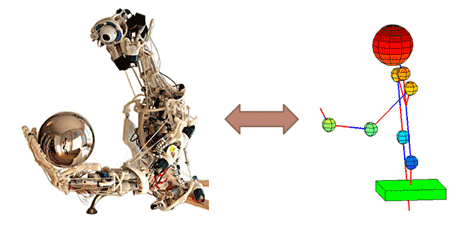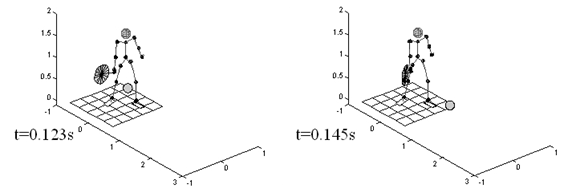General interest of ETF Robotics has always been in the field of robot dynamics, design, control and application. We mention few results that could be considered as pioneering in robotics:
- Computer-aided generation of dynamic equations – world first algorithm based on Lagrange equations
- World first CAD system for robots
- Constrained robot motion
- Distributed positioning for redundant robots
- Dynamics of robots with elasticity in joints
- Introducing the new field – robotic handwriting
PROJECTS
ECCEROBOT
The recent ETF (School of Electrical Engineering) engagement as a partner in EU-funded FP7 project ECCEROBOT (Embodied Cognition in a Compliantly Engineered Robot) and the role of ETF to provide engineering aspects of control, induced this focus of interests (anthropomimetic robots). The complexity of the control problem lies in the fact that we consider a multi-joint robot imitating human upper body, driven by antagonistic “muscles” with compliance. This means that a joint is driven by a pair of “muscles” acting like agonist and antagonist. Each “muscle” consists, in fact, of a DC motor winding a rope attached to the “bone” thus becoming a tendon. The tendon includes an elastic, expendable element.
Virtual laboratory for distance learning in Robotics and Mechatronics
The idea is to allow distance learning in technical disciplines (like Robotics) where the need for laboratory exercises restricts the possibilities. The Virtual Laboratory for Robotics and Machatronics starts from the sophisticated mathematical models of system dynamics to ensure that the virtual system will behave in the same manner as a real one would. Programming interface is identical to the interface used with real systems. The results of dynamic model and simulation are presented and visualized by using diagrams and high-quality animation. The virtual lab not only behaves as a real system and can be watched in work, but offers options not possible or allowed in a real system (overloading, changing motors, changing control concepts, removing robot cover to reveal inner mechanisms in motion, etc.).
Modeling and simulation of human/humanoid in complex human-like motions including sports
The mathematical models have been developed to represent and solve the dynamics of any humanoid configuration in any motion task. Particular motions in every-day activities, sports, etc. are considered and solved as special cases of a general theory. Model and software have been checked on bipedal posture stability under disturbances, walking, jumping, handball and basketball actions, soccer, tennis… This work is done within the project Humanoid Robotics – Theory and Application, supported by the Serbian Ministry of Science and Technological Development.
Robotic Handwriting
The concept of Distributed Positioning (DP), previously formulated for robots, was applied to resolve the redundancy problem in handwriting. The DP concept consists in separating the original end-effector motion to slow global and fast local motion and assigning these components to robot joints according to their dynamic capabilities: slow component to massive basic configuration and fast component to light redundancy. In handwriting, the relationship between finger involvement, legibility, and letter inclination was found and the existence of an optimal inclination for a prescribed legibility was proved. Degeneration of handwriting with the progress of fatigue was shown. Robotic assistance to correcting the handwriting disorders was seen as the final target.







